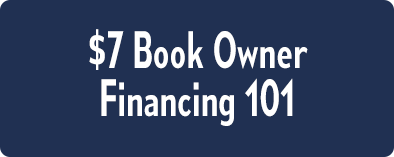PODCAST
Partnering With Your Seller with Tye Glover


Mitch Stephen chats with
Tye Glover
Episode 301: Partnering With Your Seller with Tye Glover

Many people used to have pensions, but the pensions are going away and folks are forced into 401(k)s which creates a difficult situation for a lot of people. Tye Glover was in a similar difficult situation, but he learned to increase his property’s value through partnership. In 2011, Tye had to sell his home as part of his divorce settlement. Realizing that, from experience, the homeowner and the actual flipper are the ones that are adding value to the property, he took what he learned and started focusing on the homeowner’s point of view with his real estate deals. In this episode, Tye talks about their company, Invest Out, and finding a win-win relationship by partnering the homeowner with the seller. He believes this innovative model can help many people especially as we’re moving into difficult economic times.
—
Watch the episode here:
I’m here with Tye Glover and we’re going to be talking about a unique concept that I haven’t heard much about in my 24-year career. He’s going to be talking about how to partner with the seller of the house to increase the value of the house and then share some forced appreciation. I do need to pay homage to my sponsor, TaxFreeFuture.com. If you are not investing in a tax-free or tax-deferred environment, savings account, if you will, then you have no idea the advantages you’re leaving on the table. Go to their website and check out the 37 videos because you will not believe what your financial advisors are not telling you. We’re going to tell you exactly what they’re not telling you and why they’re not telling you. Tye, we have to pay the bills, if you will. Do you ever deal in any tax-free retirement plans, IRAs or 401(k)s?
I haven’t done that. I had my own 401(k)s and obviously, that’s the whole segue as to how I got into this. Many folks used to have pensions. The pensions are going away and folks are forced into 401(k)s, which creates a difficult situation for a lot of people, especially when they don’t know that.
They have to get educated and they’re not going to teach you in school anything that’s worth real money. You have your 401(k) and it’s not that hard to set one up and anyone can set one up. It’s what do you do with a small amount of money to grow it into a large amount of money, which is part of what those videos do. I started all of mine at $150. I would be embarrassed even to tell you how much they’re worth right now because they’re worth a lot, but there are things to do about it. That’s one of the things we explained. The other thing is you don’t have to buy and sell anything. You can loan your money to Tye or me or someone with a good plan that pledges good collateral or has a tremendous track record and you can make a rate of return that’s passive.
You put your money out and let your money work. You need to build it up somehow and usually how you build things up is to buy something at $0.50 and sell it for $1. At least do it a few times in a row. It’s a life-altering. I don’t know why they don’t teach this stuff in the basics of even high school. It’s not that complicated. At high school, a person can understand how to make a profit and keep it. Tell us a little bit about your background. Where are you from? You’re from the supply side. Tell me what that is and what you used to do and what you’re doing now?
Pretty much most of my life I’ve been in the supply chain space. Distribution planning and getting product A. How much does a company need to make in order to satisfy the customer needs? I’ve worked everywhere from the telecom sector to the pharmaceuticals. It wasn’t until I got into the whole question of a divorce, a very difficult one that the whole concept as far as being able to partner with the homeowner started to evolve. That was back in 2011 and I was going through a difficult point in my life. I’m having to sell my home simply because it’s being divided up as far as the assets were concerned. I know that my house needs a lot of work because we tore out our kitchen about six months earlier and that probably caused the divorce in the first place. Recognizing the fact that our house could not even comply with FHA requirements because of all the issues associated with it. I started getting these offers from lenders or from wholesalers and so forth that were far below what I knew the property would be worth, especially in the neighborhood that I live in. That’s where my head started spinning around trying to figure out a way out of that situation.
Sometimes inventions come right out of necessity or most of the time. You’ve got this problem. You’re talking about being on one side and partnering with sellers on the other side, but the tables are turned. You are the homeowner. You’re trying to find a buyer/flipper to partner with or remodeler/flipper. Are you going to go with a remodeler/flipper or are you just going to partner with a remodeler?
Literally three doors down is the same identical footprint as my house, 1892 Victorian. The house was being renovated. Somebody was flipping that property. I got it for $150,000 and they were adding about $150,000 into it for resale of $579,000. They were making a lot of money off that property. I started looking at the fact that the homeowner who I’d known for years was walking away pretty much with very little as far as the value of the property is concerned. I do look at working with actual flippers itself. They understand how to get into the property and how to add the property. They’re in it for profit, but I think the way I’ve changed things and the way I look at things as the completely different orientation from most flippers or investors or wholesalers and lenders. I am coming from the standpoint of looking at it from the homeowner and investor standpoint. I don’t consider the wholesaler or the lender into the deal. The homeowner and the actual flipper are the ones that are adding value to the property. That’s my orientation based on my experience.

Partnering With Your Seller: The homeowner and the actual flipper are the ones that are adding value to the property.
I think you’d probably be able to find the right amount of customers. Thinking about how would you brand, “My name is so-and-so Company and we’ll help fix up your house before you sell it so you can get the maximum price.” I don’t know exactly how you brand that, but I’m sure there are a lot of people out there in that boat. You’d be on to something there, I feel like. My gut instinct says. My only issue is if I was going to do that and I was going to put $150,000 into someone’s house or even $25,000 into someone’s house. I would want to own the house technically and agree to share the profit upside if and when that happens so that my money couldn’t get shut down in someone else’s house.
It’s been seen in my industry where people have bought a house on a lease option and they’ve fixed it up nice. When it comes the time to exercise the option, the seller being a jerk says, “You can’t afford the house now. You fixed it up too nice.” I don’t want that turn and say like, “I partnered with you to put $50,000 in your house to make it worth an extra $100,000 so I can make $25,000 and you can make an extra $25,000.” They look at me and go, “The house is nice now. I don’t want to sell. I think I’m just going to stay.” How are you going to stop that?
We take on a similar idea as a wholesaler and that we secure the property. We make sure that in fact the value is added to the property. We make sure there’s no one living in the property so that you can’t get that squatters situation or position, but we feel pretty confident in the actual positioning of our legal agreements to make sure that we’re protecting the house and the investors’ investment.
At the end of the day with your paperwork, you’ll have the right to say so that the house will sell for how much.
All of that’s agreed upon. You have to walk into the deal knowing exactly what I believe the property to be worth. You have to know what I can get the property to and also how much I’m going to invest. The last thing is you have to know what percentage we’re going to be sharing of that profit that comes out of the property. You basically agree upon that with the actual homeowner itself. You’re securing a perfect understanding as to who’s going to get what out of the deal.
I see it as a pretty easy sale up front. Your paperwork and your explanation, your disclosures have to be strong because if there’s going to be an issue with this, it will be at the end. Especially if the house doesn’t sell for quite as much as you predicted or the expenses to get it to closing is a little bit more than you predicted. There are a lot of variables there and that’s hard for me to even hit the numbers on a rehab. I’ve been doing it for 24 years. It seems like there’s always a cost overrun and the profit margins are a little smaller than what we figured on paper on day one. It’s always a shrinking profit number. Do you have the name of your company yet?
Our company’s name is Invest Out. We’re taking that orientation of the homeowner again. For a lot of investors, they can’t get into the head of a homeowner. A homeowner who’s going through a difficult situation and we know that everybody has life challenges in their life. That’s part of life. We’re focusing on those ones who know that their property is worth more than what they’re being told and they need to, not necessarily just want to. A lot of homeowners want to sell, some folks are being forced. They need to sell their property and we believe that they deserve as much is they can get out of their home in addition to that flipper. Whoever’s going in there and adding value, we believe there’s a win-win relationship that could be created by partnering the two together.
You have to walk into the deal knowing exactly what you believe the property to be worth. Share on XYou have a white paper you want to give away. It’s called Flip to Partnering in 90 Days. If you guys want to go to 1000houses.com/Tye. You can go there and get this white paper, Flip to Partnering in 90 Days. He’s going to be following the option of partnering with the seller. I take it that your seller has to be out of the house?
We want them out of the house. There are a number of different ways and we’ve looked at prices or at least investments as far as little as $10,000, for example, to be able to add that cosmetic value to the home. There’s obviously an opportunity for a flipper to be able to negotiate with that homeowner, but my preference would be to make sure that the person is out of the house to further secure the property.
You can’t leave them in the house because there are going to be problems and then if anything’s missing, I think you’ve got to take possession of the house. Even maybe change the locks so that if your contractors are leaving some tools or anything in there, there’s no question. The house will be insured already still by the owner.
That’s one of the things that we’re looking at exactly. The homeowner obviously is still making payments on the mortgage or owns the property outright. They’re responsible for all those different aspects. In total, the actual investors should be spending less money when it comes to that property because, in fact, they are not having to go and secure the property. They do not have to finance it. They’re not having to pay the monthly fees associated with the upkeep of the property that’s still falling underneath the realm of the homeowner. It’s one of those negotiative opportunities for that homeowner and the investor to be able to discuss who’s going to take on what.
What part of the country are you living in?
We’re in the Philadelphia area, so we’re looking at targeting initially this northeast corridor or region, going up to New Jersey, down to Baltimore area and even DC.
You’re in a place where the houses are pretty expensive, which is a good place to be with this strategy, I imagine. If you’re dealing in cheaper houses, it’s hard to clear enough room for two people to be happy. When you’re in more expensive houses, there are bigger profit upswing opportunities. Have you ever heard the word forced appreciation?

Partnering With Your Seller: A lot of Baby Boomers are moving and transitioning out of their houses, and their houses have to be reconditioned.
I guess I have.
That’s what you’re doing. You’re forcing appreciation by doing an addition or doing a remodel.
That’s what investors or flippers do all the time. I think one of the reasons why we liked the northeast corridor here is because 44% of the homes were built before 1969. You’ve got age and inventory.
There’s a guy that I talked to in Austin, Texas who was forcing appreciation. What he did was he found these well-to-do neighborhoods that were allowing you to put an extra structure in the backyard, like a mother-in-law suite and they had limits. They couldn’t be two stories. They can only be single story and they can only be a maximum of 800 square feet. He went at 800 square feet to everybody’s lot that he could. He was looking for these lots or he goes to MLS. He is looking for the opportunity where there was room on the lot to add another structure. Where the house was either up front far enough or back far enough that there was a room or that he could pick up an extra lot next to the house that was there and then tries to buy the house and the lot to do the extension.
He was doing well with that theory because he was able to find a lot of houses within a certain neighborhood where he could buy them and pay almost market prices. The better you buy, the better the deal always. He can almost pay the market price and then go in and put it in the 800-foot structure and still make $50,000, $75,000 even if he didn’t buy the house at a discount. If he bought the house at a discount, he could make more. Have you thought about that exact scenario adding the mother-in-law suites to properties?
No, we hadn’t thought about that specifically. I was driving for Uber and Lyft for a little bit awhile back. I had an opportunity to go into any number of neighborhoods and talk to a whole lot of people. I’m a talker. I talk to all the different passengers and hearing some of their stories. When you talk about what you’re doing and how applicable their model is or how applicable the model could be to their situation. I’ve spoken with parents who have children who are special needs children. They had to go in and structure the house to be able to support the child with a wheelchair and now you have to tear all that out of the home to be able to prepare it for the next homeowner.
You can think the same thing about retiring or transitioning in place for the Baby Boomers who are moving, transitioning out of their houses and their houses have to be reconditioned. There’s one specific area that we were looking at even here in the Philadelphia area where you can get as a homeowner low-cost money to renovate your home because the city’s trying to get people to not move out of their neighborhoods. Here’s an opportunity for an investor to come in there and leverage the loan that you can get from the extra property itself due to renovation and still the homeowner can move out of the property and get that extra value while getting the city to finance the deal.
A win-win relationship could be created by partnering the homeowner and the flipper together. Share on XWhat kind of money does the city offer? Do you know?
The city was offering I believe 75% as far as the actual costs associated with the refi for the home just to be able to help those homeowners add the value to their homes and stay in those homes.
Do you know what kind of interest were they charging or how long the loan is?
That scenario I have to dig down into. We haven’t focused in on it as of yet. We just see it as an opportunity.
I’ve tried some of those government programs myself. Sometimes they’re more work than they are. I’d rather pay the regular price because by the time I get jumping through their hoops, it’s too much.
We think of it from the standpoint of even the companies that go in there and do the paperwork for the solar panels to go on the roof and so forth. Sometimes you can find that path that’s streamlined and make it that much more simple.
I do want to the point that out. I had my ideas about what would complicate this, but I always ran away from the complication. Sometimes when there’s a complication, if you’ll go right to it and try to simplify the process, you can get through the complication a different way and streamline it. You don’t know unless you roll up your sleeves and get nose-to-nose with every issue and figure out what you can do. When this works, I imagine it’s a beautiful thing.

Partnering With Your Seller: There’s an opportunity to be able to remove wholesalers from the whole market because they don’t add any value to the process.
We believe so. I know it would have added a tremendous amount in my pocket. The deal down the street with the house I had mentioned, the woman who sold could have walked away with an additional $179,000 from that deal, from the profit that was created from the renovation. The homeowner or the investors still would’ve gotten a 90% ROI if they had negotiated that 50/50 split. We think it can be a game changer from the standpoint of really instead of the push strategy that’s used to get homes through all the wholesalers, the yellow tags and so forth. We think that this could be a pull strategy by marketing directly on Facebook. Homeowners want to sell and get as much money as they can if you can control the emotion, the involvement as well as feel or deal with that need that the homeowner has. Everyone wants to make as much money as they can off of an asset.
You’re going to create some serious competition for house flippers if you make this work for sure. If you can get a reputation for this because you’re a better choice for the seller probably in 98% or 95% of the time. The only thing is if they don’t have enough time even to consider a remodel, then the house flipper/investor’s going to win. Remodels take time and sometimes these people don’t have time that’s why they sell for the price as they do in a hurry.
We’re not a good fit for the ones that are losing the property. There’s no equity in the property. It does us no good if there’s no equity in the property. It has to be something that there is value still left in the property, but we believe our primary target will be with the wholesalers. I believe that there’s an opportunity to be able to remove them from the whole market, this specific area because they don’t add any value to the process. They had cost on and they take away the profit from the homeowners and from the actual flippers itself.
We’re here with Tye Glover. I want you to go to, REIinvestorSummit.com/Tye and get your free white paper Flip to Partnering in 90 Days. It’s been nice talking with you, Tye. Is there anything you want to say to the people reading this?
I wanted to thank you for the opportunity to be able to speak with you. It’s a pleasure. We think that this is an innovative model. We think its time has come, especially as we move into more difficult economic times. People need that financial mobility and that’s what we’re hoping to help them obtain as well as a strong ROI for the actual investor.
I want you to stay in touch with me and let me know how it goes. Get me some case studies out there.
I definitely will and I truly appreciate it. Thank you very much.
I’d like to thank all the readers for stopping by to get you some Tye Glover and learn about the idea of partnering with your seller to help increase their profit. I’d also like to thank TaxFreeFuture.com for sponsoring this episode. Please go to their website and watch the 37 little video vignettes and learn why your financial advisor’s not telling you some things. There are a lot of things they’re not telling you, and we’re going to explain that and why that’s happening.
Important Links:
- 1000houses.com/Tye
- 1000houses.com/VAHelp
- 1000houses.com/moat
- 1000houses.com/101
- 1000houses.com/Coaching
- Tye Glover
- TaxFreeFuture.com
- Invest Out
About Tye Glover
 My name is Ty Glover, father of 2. I have BA in Marketing, a Masters in International Business, 20 years in the supply chain process design space, the involuntary participant in a disastrous level 10, 5-year long divorce process, and the target of numerous flippers/ wholesalers as I battled my way out of a bad marriage.
My name is Ty Glover, father of 2. I have BA in Marketing, a Masters in International Business, 20 years in the supply chain process design space, the involuntary participant in a disastrous level 10, 5-year long divorce process, and the target of numerous flippers/ wholesalers as I battled my way out of a bad marriage.











